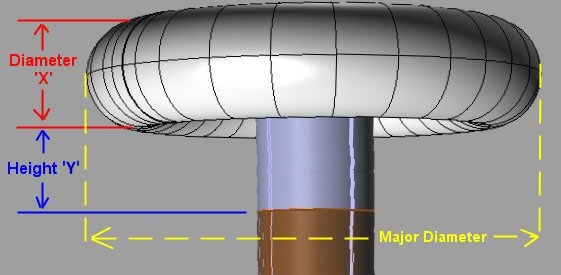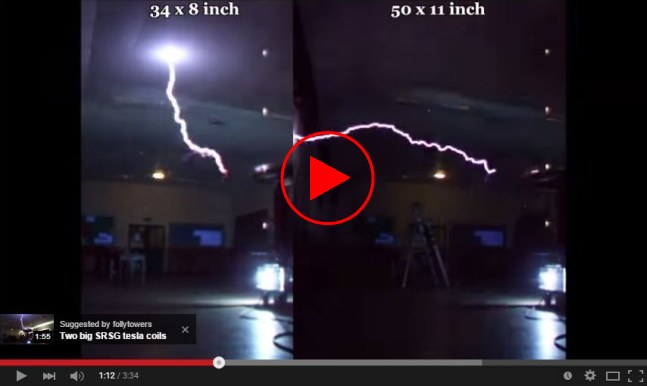Size IS Everything
Search this site:

Toroid Height & Size
The toroid not only acts as a capacitor to hold the HV charge, but also serves the purpose of offering some electrostatic shielding to the secondary and, although limited in strength, to the primary as well. Without shielding you would get excessive corona or even break-out from the top of the secondary winding. Therefore placing it too high will mean you loose the benefit of any shielding.
On the other hand, placing it too low will mean it will act like a shorted turn at the top of the secondary, which will then waste power. So getting it the optimum height is fairly important.
Basically you want to place it as high as you can without the top of the secondary breaking out.
A good upper starting point would be with the toroid positioned so that height 'Y' = 0.8 of diameter 'X' - (see below).
The final position (probably a bit lower) is only really found by trial and error. This is can be done by running the coil in the dark and adjust the variac so it's just short of breaking out, and then photographing it on a longer shutter time to detect any breakout from the top of the secondary.

(Confession time)
My own 8 inch "Phoenix" coil had its first run using a 6 x 24 inch toroid, and immediately suffered from break-out from the secondary, lowering it though quickly solved the problem.
When I later measured it, I found the height 'Y' prior to adjusting had been about 1.2 times diameter 'X'.
As a quick guide the actual size of the toroid depends on the size of the secondary and power of the coil. There are no real hard and fast rules, although it is generally accepted that the minor diameter will not be much larger than 1.5 x the diameter of the secondary coil.
In general though on smaller and medium coils the ratio is usually about 1:1, while on around 8 inch secondaries or more it can be higher, so long as the coil's top voltage is sufficient.
The overall toroid diameter would normally be 2.5 to 5 times the secondary diameter. Other people may aim for a maximum diameter that is about 80 to 90% of the actual winding height though. Bigger, is better than smaller though, as most of the good performing coils have large major diameter toroids.
Minor Diameter:
The larger the diameter of a curved surface is, the higher the voltage needs to be before breakout can occur. So a 6 inch diameter curve will breakout before an 8 inch diameter can. This means if the minor toroid diameter is small, it will break out early and not allow sufficient voltage to build up before breakout occurs, the result being the streamers will be shorter and weaker.
A correctly sized toroid is one which will allow a healthy charge to build up before break-out occurs. You will then get a nice solid streamer, usually a single one, or two at the most, that is longer than that produced by the multiple streamers that emit from a smaller minor diameter toroid.
A toroid that has too big a minor diameter, will not have any breakout at all unless you add a breakout point. This is a small rod or tack sitting on the toroid's surface, and it allows the charge to leave the toroid easily.
If a toroid can't break-out at all, it can often cause flashover on the secondary, as the built-up energy attempts to get back down to earth, by any means possible. This can be confused with 'racing sparks', where sparks shoot vertically up and down the secondary coil surface. The usual culprit behind racing sparks however, is that the coupling is too tight, so always check that aspect first if it occurs.
To alter the coupling you would need to either raise the secondary (& toroid) in respect to the primary, or else lower the primary in respect to the secondary.
My own coil needs about 80% power before breakout occurs, when not using a break-out point, which I consider to be a good goal if you want long streamers. If breakout occurred at less power without using a breakout point, it would indicate the minor diameter is too small.
Overall Diameter:
The shape of a toroid is a far better choice than the sphere that most of the early coils used, and it was first widely seen on coils built by the legendary American coiler Bill Wysock back in the 1970s.
Apart from supplying capacitance to the secondary circuit, its other main use is to provide electro-magnetic shielding to the secondary and primary coil, a perfect demonstration of this can be seen in my video.
This interesting video is a comparison between a 34" x 8" toroid and a 50" x 11", (kindly loaned by P Strauss). It not only stopped primary strikes but also gave brighter and more intense streamers.
Apart from retuning, only the toroid was changed, with power levels kept to exactly the same level. The coil's position was not altered either.
(Video runs in split screen mode for comparison.)
Update 5th July 2010:
With my old 6 x 24 toroid I had a secondary resonant frequency of around 88kHz. The new larger 8.5 x 34.5 toroid gave me an incredible, and obviously wrong, frequency of 97kHz!!!
How? Well to cut a long story short after a lot of head scratching I found the central mounting post was not in contact with the toroid's foil surface.
Without a toroid the secondary resonates at 138kHz. The new toroid was sat so close to the top of the secondary (but not in electrical contact with it) that it lowered that 138kHz down to 97kHz just by its proximity.
The correct frequency is now in the region of 80kHz (dependant on the surroundings).
With my old 6 x 24 toroid I had a secondary resonant frequency of around 88kHz. The new larger 8.5 x 34.5 toroid gave me an incredible, and obviously wrong, frequency of 97kHz!!!
How? Well to cut a long story short after a lot of head scratching I found the central mounting post was not in contact with the toroid's foil surface.
Without a toroid the secondary resonates at 138kHz. The new toroid was sat so close to the top of the secondary (but not in electrical contact with it) that it lowered that 138kHz down to 97kHz just by its proximity.
The correct frequency is now in the region of 80kHz (dependant on the surroundings).
